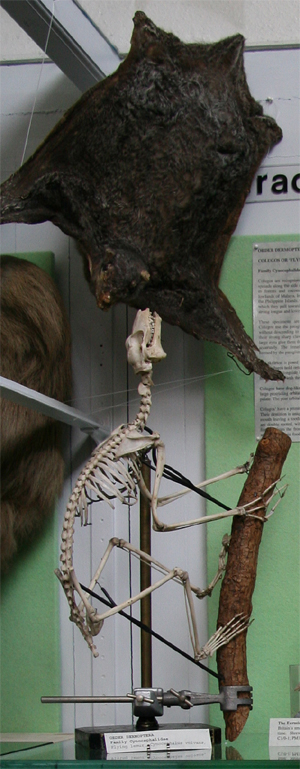
CLADE EUARCHONTIGLIRES
ORDER DERMOPTERA
COLUGOS OR 'FLYING LEMURS'
|
Family Cynocephalidae: 2 species of Cynocephalus. Colugos are recognised by the patagium - a kite-shaped membrane that spreads along the side of the body between their very long legs. They live in forests and coconut and rubber plantations in the mountains and lowlands of Malaya, Indochina and the island chain that runs eastward to the Philippine Islands. Colugos feed at night on leaves, flowers and buds, which they pull towards them with their front feet and pick off with their strong tongue and lower incisors. These specimens are Cynocephalus volvans, the Philippine colugo. Colugos use the patagium to glide from tree to tree in the forest canopy without descending to the ground. They lose height as they glide but use their strong sharp claws to climb and regain the height they lose. Their large eyes give them the stereoscopic vision needed to judge their landings accurately. The female carries her single offspring safely in a pouch formed by the patagium underneath her tail, even when gliding. Our skeleton is posed on its very long legs on a rather thin branch. In the wild, colugos hold onto tree trunks with their fore limbs while folding their hind limbs alongside their bodies. They move around by hanging down from branches with their claws. Colugos have dog-like heads: their skulls and heads are broad due to the large protruding orbital cavities; their snouts are short and broad with a flat palate. The post orbital bar is nearly complete. Colugos’ have a primitive dental formula: I3/3; C1/1; P4/4; M 3/3 = 44. Their dentition is unique – the three upper incisors grow at the side of the mouth leaving a toothless gap at the front of the jaw. The lower incisors are double rooted, with many tines growing from each tooth, and project forward from the front of the jaw. These tooth combs may be used as scrapers, to strain food and/or to groom the fur. The molars are broad. |
 |






